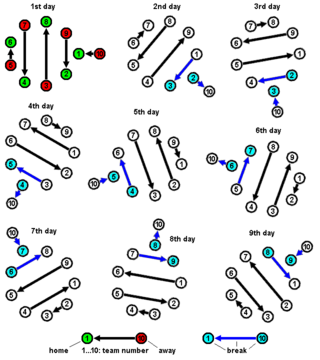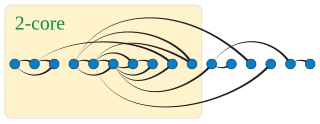Related Research Articles
Minimax is a decision rule used in artificial intelligence, decision theory, game theory, statistics, and philosophy for minimizing the possible loss for a worst case scenario. When dealing with gains, it is referred to as "maximin" – to maximize the minimum gain. Originally formulated for several-player zero-sum game theory, covering both the cases where players take alternate moves and those where they make simultaneous moves, it has also been extended to more complex games and to general decision-making in the presence of uncertainty.
A solved game is a game whose outcome can be correctly predicted from any position, assuming that both players play perfectly. This concept is usually applied to abstract strategy games, and especially to games with full information and no element of chance; solving such a game may use combinatorial game theory and/or computer assistance.
Collision detection is the computational problem of detecting an intersection of two or more spatial objects, commonly computer graphics objects. It has applications in various computing fields, primarily in computer graphics, computer games, computer simulations, robotics and computational physics. Collision detection is a classic problem of computational geometry. Collision detection algorithms can be divided into operating on 2D or 3D spatial objects.
Combinatorial game theory measures game complexity in several ways:
- State-space complexity,
- Game tree size,
- Decision complexity,
- Game-tree complexity,
- Computational complexity.

In theoretical computer science, the time complexity is the computational complexity that describes the amount of computer time it takes to run an algorithm. Time complexity is commonly estimated by counting the number of elementary operations performed by the algorithm, supposing that each elementary operation takes a fixed amount of time to perform. Thus, the amount of time taken and the number of elementary operations performed by the algorithm are taken to be related by a constant factor.

Smriti Zubin Irani is an Indian politician and former actress, fashion model and television producer. She was Minister of Women and Child Development from 2019 to 2024, and also Minister of Minority Affairs from 2022 to 2024. She previously served as Minister of Human Resource Development, Minister of Textiles, and Minister of Information and Broadcasting. She was the youngest minister in prime minister Narendra Modi's second ministry in 2019.

A round-robin tournament or all-play-all tournament is a competition format in which each contestant meets every other participant, usually in turn. A round-robin contrasts with an elimination tournament, wherein participants are eliminated after a certain number of wins or losses.
In video games, artificial intelligence (AI) is used to generate responsive, adaptive or intelligent behaviors primarily in non-playable characters (NPCs) similar to human-like intelligence. Artificial intelligence has been an integral part of video games since their inception in the 1948, first seen in the game Nim. AI in video games is a distinct subfield and differs from academic AI. It serves to improve the game-player experience rather than machine learning or decision making. During the golden age of arcade video games the idea of AI opponents was largely popularized in the form of graduated difficulty levels, distinct movement patterns, and in-game events dependent on the player's input. Modern games often implement existing techniques such as pathfinding and decision trees to guide the actions of NPCs. AI is often used in mechanisms which are not immediately visible to the user, such as data mining and procedural-content generation. One of the most infamous examples of this NPC technology and gradual difficulty levels can be found in the game Punch-Out!!.
In game theory, an n-player game is a game which is well defined for any number of players. This is usually used in contrast to standard 2-player games that are only specified for two players. In defining n-player games, game theorists usually provide a definition that allow for any (finite) number of players. The limiting case of is the subject of mean field game theory.
The Z. R. Irani Cup, also known as the Irani Trophy,, is an annual first-class cricket match organised by the Board of Control for Cricket in India (BCCI) and contested each season by the reigning Ranji Trophy champions and a multi-state Rest of India team (ROI) composed of players from the other state teams. The inaugural edition was played in March 1960 as a special event to commemorate the 25th anniversary of the Ranji Trophy. It was intended to be a one-off match but, in 1962, BCCI decided to institute it as annual fixture and it has been played in most seasons since 1962–63. BCCI named the Irani Trophy after Zal R. Irani, their long-serving president and treasurer, who was a significant figure in the organisation from its inception in 1928, till his death in 1970.

Karnataka cricket team represents the Indian state of Karnataka in domestic cricket competitions. It has traditionally been one of the strongest teams in the domestic circuit and has produced many of Indian cricket team's iconic players. It was known as Mysore cricket team before the state of Mysore was officially renamed as Karnataka in 1973. It has won the Ranji Trophy eight times and has come second six times. The team's home ground is the M. Chinnaswamy Stadium in Bengaluru. There was a major push in cricketing infrastructure in 2010s and as of now, grounds in Bengaluru, Mysuru, Hubballi are constantly used in Ranji Trophy, Vijay Hazare Trophy & Karnataka Premier League
God's algorithm is a notion originating in discussions of ways to solve the Rubik's Cube puzzle, but which can also be applied to other combinatorial puzzles and mathematical games. It refers to any algorithm which produces a solution having the fewest possible moves. The allusion to the deity is based on the notion that an omniscient being would know an optimal step from any given configuration.
Game Description Language (GDL) is a specialized logic programming language designed by Michael Genesereth. The goal of GDL is to allow the development of AI agents capable of general game playing. It is part of the General Game Playing Project at Stanford University.
In statistics and machine learning, discretization refers to the process of converting or partitioning continuous attributes, features or variables to discretized or nominal attributes/features/variables/intervals. This can be useful when creating probability mass functions – formally, in density estimation. It is a form of discretization in general and also of binning, as in making a histogram. Whenever continuous data is discretized, there is always some amount of discretization error. The goal is to reduce the amount to a level considered negligible for the modeling purposes at hand.
Congestion games (CG) are a class of games in game theory. They represent situations which commonly occur in roads, communication networks, oligopoly markets and natural habitats. There is a set of resources ; there are several players who need resources ; each player chooses a subset of these resources ; the delay in each resource is determined by the number of players choosing a subset that contains this resource. The cost of each player is the sum of delays among all resources he chooses. Naturally, each player wants to minimize his own delay; however, each player's choices impose a negative externality on the other players, which may lead to inefficient outcomes.
In algorithmic game theory, a succinct game or a succinctly representable game is a game which may be represented in a size much smaller than its normal form representation. Without placing constraints on player utilities, describing a game of players, each facing strategies, requires listing utility values. Even trivial algorithms are capable of finding a Nash equilibrium in a time polynomial in the length of such a large input. A succinct game is of polynomial type if in a game represented by a string of length n the number of players, as well as the number of strategies of each player, is bounded by a polynomial in n.
John Luckhardt is a former American football player and coach. He was the head football coach at California University of Pennsylvania in California, Pennsylvania from 2002 to 2011. Luckhardt coached at Washington & Jefferson College from 1982 to 1998, where he compiled a record of 137–37–2 and posted a school record for wins. He was elected to the Washington & Jefferson College Athletics Hall of Fame in 2007. Luckhardt was inducted into the College Football Hall of Fame as a coach in 2022.

In graph theory, a k-degenerate graph is an undirected graph in which every subgraph has a vertex of degree at most k: that is, some vertex in the subgraph touches k or fewer of the subgraph's edges. The degeneracy of a graph is the smallest value of k for which it is k-degenerate. The degeneracy of a graph is a measure of how sparse it is, and is within a constant factor of other sparsity measures such as the arboricity of a graph.
The Lemke–Howson algorithm is an algorithm that computes a Nash equilibrium of a bimatrix game, named after its inventors, Carlton E. Lemke and J. T. Howson. It is said to be "the best known among the combinatorial algorithms for finding a Nash equilibrium", although more recently the Porter-Nudelman-Shoham algorithm has outperformed on a number of benchmarks.
In computer science, Monte Carlo tree search (MCTS) is a heuristic search algorithm for some kinds of decision processes, most notably those employed in software that plays board games. In that context MCTS is used to solve the game tree.
References
- ↑ Luckhardt, Carol A.; Irani, Keki B. (11 August 1986). An Algorithmic Solution of N-Person Games (PDF). AAAI '86. pp. 158–162. Archived (PDF) from the original on 19 April 2024. Retrieved 20 August 2024.